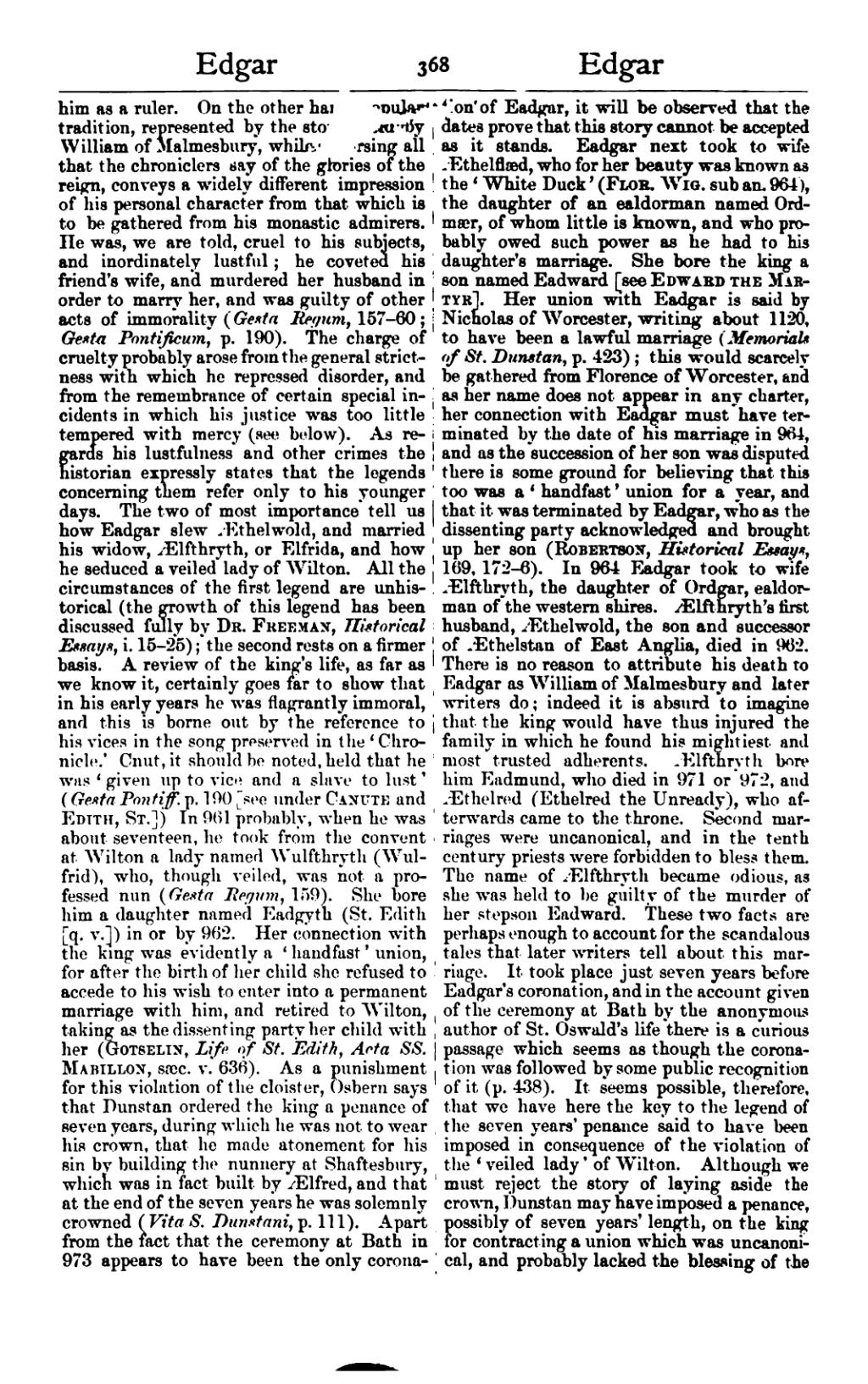him as a ruler. On the other hand, popular tradition, represented by the stories told by William of Malmesbury, while endorsing all that the chroniclers say of the glories of the reign, conveys a widely different impression of his personal character from that which is to be gathered from his monastic admirers. He was, we are told, cruel to his subjects, and inordinately lustful; he coveted his friend's wife, and murdered her husband in order to marry her, and was guilty of other acts of immorality (Gesta Regum, 157–60; Gesta Pontificum, p. 190). The charge of cruelty probably arose from the general strictness with which he repressed disorder, and from the remembrance of certain special incidents in which his justice was too little tempered with mercy (see below). As regards his lustfulness and other crimes the historian expressly states that the legends concerning them refer only to his younger days. The two of most importance tell us how Eadgar slew Æthelwold, and married his widow, Ælfthryth, or Elfrida, and how he seduced a veiled lady of Wilton. All the circumstances of the first legend are unhistorical (the growth of this legend has been discussed fully by Dr. Freeman, Historical Essays, i. 15–25); the second rests on a firmer basis. A review of the king's life, as far as we know it, certainly goes far to show that in his early years he was flagrantly immoral, and this is borne out by the reference to his vices in the song preserved in the ‘Chronicle.’ Cnut, it should be noted, held that he was ‘given up to vice and a slave to lust’ (Gesta Pontiff. p. 190 [see under Canute and Edith, St.]) In 961 probably, when he was about seventeen, he took from the convent at Wilton a lady named Wulfthryth (Wulfrid), who, though veiled, was not a professed nun (Gesta Regum, 159). She bore him a daughter named Eadgyth (St. Edith) [q. v.] in or by 962. Her connection with the king was evidently a ‘handfast’ union, for after the birth of her child she refused to accede to his wish to enter into a permanent marriage with him, and retired to Wilton, taking as the dissenting party her child with her (Gotselin, Life of St. Edith, Acta SS. Mabillon, sæc. v. 636). As a punishment for this violation of the cloister, Osbern says that Dunstan ordered the king a penance of seven years, during which he was not to wear his crown, that he made atonement for his sin by building the nunnery at Shaftesbury, which was in fact built by Ælfred, and that at the end of the seven years he was solemnly crowned (Vita S. Dunstani, p. 111). Apart from the fact that the ceremony at Bath in 973 appears to have been the only coronation of Eadgar, it will be observed that the dates prove that this story cannot be accepted as it stands. Eadgar next took to wife Æthelflæd, who for her beauty was known as the ‘White Duck’ (Flor. Wig. sub an. 964), the daughter of an ealdorman named Ordmær, of whom little is known, and who probably owed such power as he had to his daughter's marriage. She bore the king a son named Eadward [see Edward the Martyr]. Her union with Eadgar is said by Nicholas of Worcester, writing about 1120, to have been a lawful marriage (Memorials of St. Dunstan, p. 423); this would scarcely be gathered from Florence of Worcester, and as her name does not appear in any charter, her connection with Eadgar must have terminated by the date of his marriage in 964, and as the succession of her son was disputed there is some ground for believing that this too was a ‘handfast’ union for a year, and that it was terminated by Eadgar, who as the dissenting party acknowledged and brought up her son (Robertson, Historical Essays, 169, 172–6). In 964 Eadgar took to wife Ælfthryth, the daughter of Ordgar, ealdorman of the western shires. Ælfthryth's first husband, Æthelwold, the son and successor of Æthelstan of East Anglia, died in 962. There is no reason to attribute his death to Eadgar as William of Malmesbury and later writers do; indeed it is absurd to imagine that the king would have thus injured the family in which he found his mightiest and most trusted adherents. Ælfthryth bore him Eadmund, who died in 971 or 972, and Æthelred (Ethelred the Unready), who afterwards came to the throne. Second marriages were uncanonical, and in the tenth century priests were forbidden to bless them. The name of Ælfthryth became odious, as she was held to be guilty of the murder of her stepson Eadward. These two facts are perhaps enough to account for the scandalous tales that later writers tell about this marriage. It took place just seven years before Eadgar's coronation, and in the account given of the ceremony at Bath by the anonymous author of St. Oswald's life there is a curious passage which seems as though the coronation was followed by some public recognition of it (p. 438). It seems possible, therefore, that we have here the key to the legend of the seven years' penance said to have been imposed in consequence of the violation of the ‘veiled lady’ of Wilton. Although we must reject the story of laying aside the crown, Dunstan may have imposed a penance, possibly of seven years' length, on the king for contracting a union which was uncanonical, and probably lacked the blessing of the
